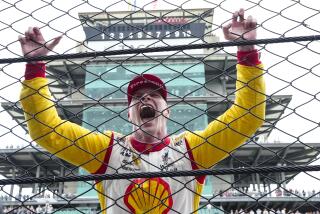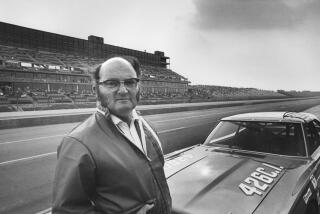Now He’s Coach Mears : He Sits in the Pits, Rather Than in a Car, but He’s Still Part of the Team
- Share via
INDIANAPOLIS — Rick Mears knew that his early retirement would be sorely tested when he got to Indianapolis.
In 1978, he came here for the first time--a rookie from Bakersfield who electrified the racing community by qualifying one of Roger Penske’s cars in the front row of the Indianapolis 500. He came back the next year and won the pole and the 500.
In a career that spanned 15 years, all with Penske, he won four 500s and sat on the pole six times, a record unmatched.
“I’ve been here a couple of weeks now, and the feeling has not changed,” Mears, 41, said as he stood alongside the red and white Penske cars of Paul Tracy, 24, and Emerson Fittipaldi, 46. “I have absolutely zero regrets. I don’t miss it.
“Indianapolis comes up, and obviously you feel a little tug here and there. But in a lot of ways, I’m doing exactly what I’ve always done here. I’m just not driving.”
Mears is still part of the Penske team, working with the drivers as sort of a second engineer, racing consultant and father confessor.
Said Tracy: “Rick is probably as good an engineer as he was a racing driver. That is a bonus for me, as a driver. Engineers don’t necessarily know what you’re feeling. Rick has been in that situation. He knows exactly what you’re feeling. He can pinpoint a problem after talking with me.”
Said Fittipaldi: “For sure, having Rick on the sidelines gives us an extra edge. He can see what is happening, and he has been there, so he can interpret for us what we need to know. For sure, he has been a wonderful teammate, and now nothing has changed. He is still with us.”
Mears, whose retirement announcement at the Penske team’s Christmas party was nearly as stunning and unexpected as A.J. Foyt’s here last Saturday, relishes his new role.
“I always felt that the more work I did on the car, the less work I had to do in the race,” he said. “The most important challenge to me was trying to get the car right, trying to make the car better than anybody else out there, and if I could, then that made the driving easier.
“Now, if I can carry that over to Paul and Emerson, I can be of great help. Working with the drivers is a learning experience for me because I have to get to know to what degree they feel what I felt. I find working toward that more rewarding that driving.”
His retirement, however, is restricted to Indy cars.
“I won’t get in an Indy car again, even to test, but as far as something else, who knows?” he said. “I may do something, like off-road or boats or something else, for fun, but I don’t have that urge yet. I’m enjoying too much what I’m doing. Toward the end of the year I’ll sit down and decide what to do next year.”
Although Mears has no second thoughts on retirement, he said the reaction of fans has been mixed.
“The majority have been very supportive of my decision,” he said. “Then, of course, there have been quite a few saying, ‘We’re going to miss you out there,’ and then there are others who say, ‘Darn, we really wanted you to try to get that fifth (Indy victory).’ I’d say, though, the majority were with me.”
The thought of becoming first to win a fifth 500 never figured in his thinking.
“Wins, records, money, none of those things ever came into place with me,” he said. “I never knew what the pay was. I didn’t care at the time. I raced for fun. I never let a purse, or a record, dictate how I raced.
“That’s what led me to hanging it up. I realized it wasn’t fun any more. If I enjoyed it as much as I did, I’d still be racing.”
Penske, who plucked Mears from a motorcycle ride through the mountains of Colorado in 1977 and saw him develop into the wizard of oval racing, says he saw the retirement coming and that he agrees with Mears’ decision.
“Last September, before anyone dreamed Rick was going to retire, we were at Elkhart Lake (Wis.) and he was hurt,” Penske said. “He wasn’t 100% and didn’t race, and he told me he didn’t really have the fire inside that he had and was thinking that this might be his last year.
“I told him to take his time and take the rest of the year to make sure that it was the right decision, that there was no pressure because we had Paul (Tracy) in the wings with a long-term contract. Rick’s a pretty smart guy. I think he knew it was the time to stop, and he did it the right way.”
Marlboro threw a surprise roast for Mears last week, but no one could think of anything negative to say about him.
“He’s such a nice guy, he even signs his name ‘Rick Mears, Thanks,’ ” said Bobby Rahal. “How can you say anything bad about a guy like that?”
More than 350 friends--including fellow 500 winners Mario Andretti, Al Unser, Al Unser Jr., Danny Sullivan, Arie Luyendyk, Rahal and Fittipaldi--managed to keep the roast a secret.
“If he was any more laid back, he’d be in reverse,” said Chris Mears as her husband sat on a reclining chair on stage, smiling at every imagined insult or barb.
The night was a celebration of Mears’ career, from his earliest days in Bakersfield to his four victories here.
Of all his successes at Indianapolis, Mears said he ranks his victory in 1991 at the top of the list.
“It was the first time I ever crashed a car here, so the month started out a little different from any other year,” he said.
Mears had driven 13 years at the Speedway without touching the walls before he spun into the concrete barriers the day before pole qualifying. Just before the crash, he had run a lap at 226.569 m.p.h.
“Then, for the Marlboro team to turn around and have a backup car ready for me to jump in and run as quick as we had all month in the primary car, and to qualify the way we did (on the pole) and then win the race, that was something special.”
Three hours after the accident, Mears climbed into the backup car, and the next day won his sixth pole.
“And in the race, we kept changing things until we got the car as strong as we possibly could have it so that if we got in a shootout, we’d be ready,” he said. “Then, it did boil down to a shootout with Michael (Andretti), who had been the fastest car on the track the whole day long. Then, to be able to pass him, to take the lead at the end, when it counted, and win the first race in the Marlboro colors!”
Twelve laps from the finish, Mears swept around Andretti--who had led 97 of 200 laps--in a dramatic pass on the high side of the track, to take the lead for good.
More to Read
Go beyond the scoreboard
Get the latest on L.A.'s teams in the daily Sports Report newsletter.
You may occasionally receive promotional content from the Los Angeles Times.










